Hosting Quota Notifications 1.X For WHMCS
(→Configuration Of Addon) |
|||
| Line 1: | Line 1: | ||
| − | + | <meta name="keywords" content="wordpress manager for whmcs, wordpress manager configuration, wordpress manager management, wordpress manager installation, wordpress manager guide, modulesgarden wordpress manager, wordpress manager wiki, wordpress manager tutorial, wordpress manager tips, wordpress module wiki, wordpress manager common problems, about wordpress manager, wordpress manager documentation, wordpress manager faq, wordpress manager help"></meta> | |
| − | <meta name="keywords" content=" | + | <meta name="description" content="ModulesGarden Wiki Contains All The Information You Need About The WordPress Manager For WHMCS Module."></meta> |
| − | <meta name="description" content="ModulesGarden Wiki Contains All The Information You Need About The | + | |
| − | =About [https://www.modulesgarden.com/products/whmcs/ | + | =About [https://www.modulesgarden.com/products/whmcs/wordpress-manager WordPress Manager For WHMCS]= |
{| | {| | ||
| − | |style="padding: 10px 0px 10px 0px;"|''' | + | |style="padding: 10px 0px 10px 0px;"|'''WordPress Manager For WHMCS''' is a module that enables your customers to control and freely alter their WordPress instances right in your WHMCS. <br /> |
| − | + | Your clients will be able to perform WordPress updates, explore and install plugins, create backups and carry out bulk actions on key elements.<br/> | |
| + | You will easily handle the list of services that shall include the WordPress management capabilities, and control customer activity thanks to module logs. | ||
|} | |} | ||
| − | |||
*'''Admin Area Features:''' | *'''Admin Area Features:''' | ||
{| | {| | ||
| − | |style="padding: 10px 0px 0px 30px;"|✔ | + | |style="padding: 10px 0px 0px 30px;"|✔ View Active WordPress Installations, Clients And Products Summary |
|} | |} | ||
{| | {| | ||
| − | |style="padding: 0px 0px 0px 30px;"|✔ | + | |style="padding: 0px 0px 0px 30px;"|✔ View WordPress Installations List |
|} | |} | ||
{| | {| | ||
| − | |style="padding: 0px 0px 0px 30px;"|✔ | + | |style="padding: 0px 0px 0px 30px;"|✔ Choose Supported Products |
|} | |} | ||
{| | {| | ||
| − | |style="padding: 0px 0px 0px 30px;"|✔ Toggle | + | |style="padding: 0px 0px 0px 30px;"|✔ Toggle Debug Logs Per Product |
|} | |} | ||
{| | {| | ||
| − | |style="padding: 0px 0px 10px 30px;"|✔ | + | |style="padding: 0px 0px 10px 30px;"|✔ Access Module Logs |
|} | |} | ||
| + | |||
*'''Client Area Features:''' | *'''Client Area Features:''' | ||
{| | {| | ||
| − | |style="padding: 10px 0px 0px 30px;"|✔ | + | |style="padding: 10px 0px 0px 30px;"|✔ View/Create/Edit/Delete WordPress Installations |
|} | |} | ||
{| | {| | ||
| − | |style="padding: 0px 0px 0px 30px;"|✔ | + | |style="padding: 0px 0px 0px 30px;"|✔ Create/Restore/Download/Delete WordPress Backups |
|} | |} | ||
{| | {| | ||
| − | |style="padding: 0px 0px | + | |style="padding: 0px 0px 0px 30px;"|✔ Browse And Install Plugins |
|} | |} | ||
| + | {| | ||
| + | |style="padding: 0px 0px 0px 30px;"|✔ Perform Bulk Changes On Plugins And Backups | ||
| + | |} | ||
| + | {| | ||
| + | |style="padding: 0px 0px 0px 30px;"|✔ Provide Installation Details | ||
| + | |} | ||
| + | {| | ||
| + | |style="padding: 0px 0px 0px 30px;"|✔ View Installation Details: | ||
| + | |} | ||
| + | {| | ||
| + | |style="padding: 0px 0px 0px 45px;"|✔ WordPress Version | ||
| + | |} | ||
| + | {| | ||
| + | |style="padding: 0px 0px 0px 45px;"|✔ Domain And URL | ||
| + | |} | ||
| + | {| | ||
| + | |style="padding: 0px 0px 0px 45px;"|✔ Product On Which Is Installed | ||
| + | |} | ||
| + | {| | ||
| + | |style="padding: 0px 0px 0px 45px;"|✔ Site Name | ||
| + | |} | ||
| + | {| | ||
| + | |style="padding: 0px 0px 0px 45px;"|✔ Creation Date | ||
| + | |} | ||
| + | {| | ||
| + | |style="padding: 0px 0px 0px 45px;"|✔ Directory Path | ||
| + | |} | ||
| + | {| | ||
| + | |style="padding: 0px 0px 0px 45px;"|✔ Database Access Details | ||
| + | |} | ||
| + | {| | ||
| + | |style="padding: 0px 0px 0px 45px;"|✔ Debug Status | ||
| + | |} | ||
| + | {| | ||
| + | |style="padding: 0px 0px 0px 30px;"|✔ Manage Installation: | ||
| + | |} | ||
| + | {| | ||
| + | |style="padding: 0px 0px 0px 45px;"|✔ Log In To Control Panel | ||
| + | |} | ||
| + | {| | ||
| + | |style="padding: 0px 0px 0px 45px;"|✔ Clear Cache | ||
| + | |} | ||
| + | {| | ||
| + | |style="padding: 0px 0px 0px 45px;"|✔ Clone To New Domain | ||
| + | |} | ||
| + | {| | ||
| + | |style="padding: 0px 0px 0px 45px;"|✔ Change Domain | ||
| + | |} | ||
| + | {| | ||
| + | |style="padding: 0px 0px 0px 45px;"|✔ Update To Newer Version | ||
| + | |} | ||
| + | {| | ||
| + | |style="padding: 0px 0px 0px 45px;"|✔ Delete | ||
| + | |} | ||
| + | {| | ||
| + | |style="padding: 0px 0px 0px 30px;"|✔ Plugins Management: | ||
| + | |} | ||
| + | {| | ||
| + | |style="padding: 0px 0px 0px 45px;"|✔ Search And Install Plugins Directly From WordPress.com Base | ||
| + | |} | ||
| + | {| | ||
| + | |style="padding: 0px 0px 0px 45px;"|✔ Update Installed Plugins | ||
| + | |} | ||
| + | {| | ||
| + | |style="padding: 0px 0px 10px 45px;"|✔ Activate/Deactivate Installed Plugins | ||
| + | |} | ||
| + | |||
*'''General Info:''' | *'''General Info:''' | ||
{| | {| | ||
| − | |style="padding: 10px 0px 0px 30px;"|✔ | + | |style="padding: 10px 0px 0px 30px;"|✔ Supports cPanel And [https://www.modulesgarden.com/products/whmcs/cpanel-extended cPanel Extended] |
| + | |} | ||
| + | {| | ||
| + | |style="padding: 0px 0px 0px 30px;"|✔ Requires [https://www.softaculous.com/ Softaculous] Auto Installer | ||
|} | |} | ||
{| | {| | ||
| Line 54: | Line 124: | ||
=Installation and Configuration= | =Installation and Configuration= | ||
{| | {| | ||
| − | |style="padding: 10px 0px | + | |style="padding: 10px 0px 15px 15px;"|'''In this short tutorial we will show you how to successfully install WordPress Manager For WHMCS.'''<br /> |
We will guide you step by step through the whole installation process. | We will guide you step by step through the whole installation process. | ||
|} | |} | ||
| + | |||
{| | {| | ||
| − | |style="padding: | + | |style="padding: 10px 0px 20px 15px;"|'''1. Log in to our client area and download the module.''' |
|} | |} | ||
{| | {| | ||
| − | |style="padding: 0px 0px 20px 25px;"|[[File: | + | |style="padding: 0px 0px 20px 25px;"|[[File:WM_S2_1.png]] |
|} | |} | ||
{| | {| | ||
| Line 71: | Line 142: | ||
|} | |} | ||
{| | {| | ||
| − | |style="padding: 0px 0px 15px 15px;"|'''3. | + | |style="padding: 0px 0px 15px 15px;"|'''3. Choose the one with the right PHP version. In the package you will find another two folders.'''<br/>As presented on the screen below, the first one is supposed to be installed on WHM (cPanel), while the second one is aimed at WHMCS. |
| − | + | ||
|} | |} | ||
{| | {| | ||
| − | |style="padding: 0px 0px | + | |style="padding: 0px 0px 30px 25px;"|[[File:WM_1s2.png]] |
|} | |} | ||
| + | ==cPanel (WHM) Installation== | ||
{| | {| | ||
| − | |style="padding: 0px 0px 15px 15px;"|''' | + | |style="padding: 0px 0px 15px 15px;"|'''1. Upload and extract the '' 'UploadToWHM' '' folder into the '''/root''' cPanel directory.'''<br /> |
| − | + | Files in your cPanel ''/root/uploadToWHM/'' directory should look like these on the following screen. | |
|} | |} | ||
{| | {| | ||
| − | |style="padding: 0px 0px 20px 25px;"|[[File: | + | |style="padding: 0px 0px 20px 25px;"|[[File:WM_2.png]] |
|} | |} | ||
{| | {| | ||
| − | |style="padding: 0px 0px 15px 15px;"|''' | + | |style="padding: 0px 0px 15px 15px;"|'''2. Once the module is uploaded, enter the '''/root/uploadToWHM/''' catalog and run the following command in the console:<br /> |
| + | sh install.sh | ||
| + | After a brief moment you should see a confirmation that the plugin has been successfully installed. | ||
| + | |} | ||
| + | {| | ||
| + | |style="padding: 0px 0px 30px 25px;"|[[File:WM_3.png]] | ||
| + | |} | ||
| + | |||
| + | ==WHMCS Installation== | ||
| + | {| | ||
| + | |style="padding: 0px 0px 20px 15px;"|'''1. Extract the '' 'modules' '' catalog into the main WHMCS directory.'''<br /> | ||
| + | |} | ||
| + | {| | ||
| + | |style="padding: 0px 0px 20px 25px;"|[[File:WM_S2_2.png]] | ||
| + | |} | ||
| + | {| | ||
| + | |style="padding: 0px 0px 15px 15px;"|'''2. When you install WordPress Manager For WHMCS for the first time, you have to rename the '' 'license_RENAME.php' '' file.'''<br /> | ||
| + | This file is located in '' 'modules/addons/wordpress_manager/license_RENAME.php.' '' Rename it from '' 'license_RENAME.php' '' to '' 'license.php'. '' | ||
| + | |} | ||
| + | {| | ||
| + | |style="padding: 0px 0px 20px 25px;"|[[File:WM_S3.png]] | ||
| + | |} | ||
| + | {| | ||
| + | |style="padding: 0px 0px 15px 15px;"|'''3. In order to configure your license key, you have to edit the previously renamed '' 'license.php' '' file.'''<br /> | ||
Enter your license key between quotation marks as presented on the following screen. You can find your license key in our client area → '' 'My Products'. '' | Enter your license key between quotation marks as presented on the following screen. You can find your license key in our client area → '' 'My Products'. '' | ||
|} | |} | ||
{| | {| | ||
| − | |style="padding: 0px 0px 20px 25px;"|[[File: | + | |style="padding: 0px 0px 20px 25px;"|[[File:WM_S4.png]] |
|} | |} | ||
{| | {| | ||
| − | |style="padding: 0px 0px 15px 15px;"|''' | + | |style="padding: 0px 0px 15px 15px;"|'''4. In the next step, set up the '' 'storage' '' folder as recursively writable.'''<br /> |
| − | + | This folder is available at '' 'your_whmcs/modules/addons/WordpressManager/' ''. | |
| − | + | ||
|} | |} | ||
{| | {| | ||
| − | |style="padding: 0px 0px 20px 25px;"|[[File: | + | |style="padding: 0px 0px 20px 25px;"|[[File:WM_S4s.png]] |
|} | |} | ||
{| | {| | ||
| − | |style="padding: 0px 0px 15px 15px;"|''' | + | |style="padding: 0px 0px 15px 15px;"|'''5. Now you have to activate the module in your WHMCS system.'''<br /> |
| − | + | Log in to your WHMCS admin area. Click '' 'Setup' '', then choose '' 'Addon Modules'. ''<br /> | |
| + | Afterwards, find '' 'WordPress Manager' '' and press the '' 'Activate' '' button. | ||
|} | |} | ||
{| | {| | ||
| − | |style="padding: 0px 0px 20px 25px;"|[[File: | + | |style="padding: 0px 0px 20px 25px;"|[[File:WM_S_3.png]] |
|} | |} | ||
{| | {| | ||
| − | |style="padding: 0px 0px | + | |style="padding: 0px 0px 20px 15px;"|'''6. Then, you need to permit access to this module. To do so, click on the '' 'Configure' '' button, choose '' 'Full Administrator' '' and press '' 'Save Changes'.'' ''' |
| − | + | ||
|} | |} | ||
{| | {| | ||
| − | |style="padding: 0px 0px 20px 25px;"|[[File: | + | |style="padding: 0px 0px 20px 25px;"|[[File:WM_S_4.png]] |
|} | |} | ||
{| | {| | ||
| − | |style="padding: 0px 0px | + | |style="padding: 0px 0px 15px 15px;"|'''7. Now you have to add a cron job as shown below (5 - 10 minutes interval is recommended).'''<br /> |
| + | php -q /your_whmcs/modules/addons/WordPressManager/cron/cron.php Synchronize | ||
| + | Do not forget to replace 'your_whmcs' with your WHMCS root location. | ||
|} | |} | ||
{| | {| | ||
| − | |style="padding: 0px 0px | + | |style="padding: 0px 0px 20px 15px;"|'''8. Good job! You have just successfully installed WordPress Manager For WHMCS! Now in your WHMCS press '' 'Addons' '' and then '' 'WordPress Manager'. '' ''' |
|} | |} | ||
| − | |||
{| | {| | ||
| − | |style="padding: 0px 0px | + | |style="padding: 0px 0px 30px 25px;"|[[File:WM_S2_6.png]] |
| − | + | ||
|} | |} | ||
| + | |||
| + | =Management= | ||
{| | {| | ||
| − | |style="padding: 0px | + | |style="padding: 10px 0px 30px 15px;"|This section has been divided into two main parts to allow full and, at the same time, easy understanding of the functionality of the whole module.<br/>In the first part '' 'Management of Addon' '' you will see a general outlook of the module's basic configuration, through the product management from the admin area.<br/> The second part describes additional settings and tools concerning WordPress installations that can be used while working in the client area. |
|} | |} | ||
| + | |||
| + | ===Admin Area=== | ||
{| | {| | ||
| − | |style="padding: 0px | + | |style="padding: 10px 0px 30px 15px;"|Now that your module is already configured, you may access it from '' 'Addons' '' → '' 'WordPress Manager' ''. |
|} | |} | ||
| + | ====Home==== | ||
{| | {| | ||
| − | |style="padding: 0px | + | |style="padding: 10px 0px 15px 15px;"|'' 'Home' '' should be your first choice. <br/> |
| + | In this section you will see all active WordPress installations and the list of the clients who already have them. | ||
|} | |} | ||
{| | {| | ||
| − | |style="padding: 0px 0px | + | |style="padding: 0px 0px 20px 25px;"|[[File:WM_S2_188.png]] |
| − | + | ||
|} | |} | ||
| + | |||
| + | ====Product Settings==== | ||
{| | {| | ||
| − | |style="padding: | + | |style="padding: 10px 0px 20px 15px;"|In the '' 'Product Settings' '' section you can see the list of compatible products that WordPress can be configured with. |
|} | |} | ||
{| | {| | ||
| − | |style="padding: 0px 0px 20px | + | |style="padding: 0px 0px 20px 25px;"|[[File:WM_181.png]] |
|} | |} | ||
{| | {| | ||
| − | |style="padding: 0px 0px 20px | + | |style="padding: 0px 0px 20px 15px;"|Activate your product and press the '' 'Edit' '' button marked with the green arrow. |
|} | |} | ||
{| | {| | ||
| − | |style="padding: 0px 0px | + | |style="padding: 0px 0px 20px 25px;"|[[File:WM_S18.png]] |
| − | + | ||
| − | + | ||
| − | + | ||
| − | + | ||
| − | + | ||
|} | |} | ||
{| | {| | ||
| − | |style="padding: 0px 0px 20px | + | |style="padding: 0px 0px 20px 15px;"|Enabling ''Debug Mode'' will result in the module's activity details being gathered in the '' 'Logs' '' tab. |
|} | |} | ||
{| | {| | ||
| − | |style="padding: 0px 0px | + | |style="padding: 0px 0px 30px 25px;"|[[File:WM_S19.png]] |
| − | + | ||
| − | + | ||
|} | |} | ||
| + | |||
| + | ====Logs==== | ||
{| | {| | ||
| − | |style="padding: | + | |style="padding: 10px 0px 20px 15px;"|All module activities are recorded in the section named '' 'Logs' ''. |
|} | |} | ||
{| | {| | ||
| − | |style="padding: 0px 0px | + | |style="padding: 0px 0px 20px 25px;"|[[File:WM_S2_32.png]] |
| − | + | ||
|} | |} | ||
{| | {| | ||
| − | |style="padding: 0px 0px | + | |style="padding: 0px 0px 20px 15px;"|All entries can be deleted separately. To do that, just click the button marked on the screen below. |
|} | |} | ||
| + | {| | ||
| + | |style="padding: 0px 0px 20px 25px;"|[[File:WM_S2_34.png]] | ||
| + | |} | ||
| + | {| | ||
| + | |style="padding: 0px 0px 20px 15px;"|Keep in mind that you can remove multiple logs at once. | ||
| + | |} | ||
| + | {| | ||
| + | |style="padding: 0px 0px 30px 25px;"|[[File:WM_S2_33.png]] | ||
| + | |} | ||
| + | |||
| + | ===Client Area=== | ||
| − | == | + | ====WordPress Management==== |
{| | {| | ||
| − | |style="padding: 10px 0px 15px | + | |style="padding: 10px 0px 15px 15px;"|Now that you already have the module configured, you may see the process of adding and and managing the WordPress installations by your clients.<br/> While in the client area, find the button '' 'My Services' '' and go to the section presented on the following screen. |
| − | + | ||
| − | + | ||
|} | |} | ||
{| | {| | ||
| − | |style="padding: 0px 0px | + | |style="padding: 0px 0px 20px 25px;"|[[File:WM_S2_18.png]] |
| − | + | ||
|} | |} | ||
{| | {| | ||
| − | |style="padding: 0px 0px 20px | + | |style="padding: 0px 0px 20px 15px;"|Choose your product and enter its details. |
|} | |} | ||
{| | {| | ||
| − | |style="padding: 0px 0px | + | |style="padding: 0px 0px 20px 25px;"|[[File:WM_S2_19.png]] |
| − | + | ||
|} | |} | ||
{| | {| | ||
| − | |style="padding: 0px 0px 20px | + | |style="padding: 0px 0px 20px 15px;"|Now, move directly to the '' 'WordPress Management' '' section. |
|} | |} | ||
{| | {| | ||
| − | |style="padding: 0px 0px | + | |style="padding: 0px 0px 30px 25px;"|[[File:WM_S2_20.png]] |
| − | + | |} | |
| − | + | ====New Installation==== | |
| + | {| | ||
| + | |style="padding: 0px 0px 20px 15px;"|Next, you will need to add a new installation. Press the button marked on the screen below. | ||
| + | |} | ||
| + | {| | ||
| + | |style="padding: 0px 0px 20px 25px;"|[[File:WM_S2_191.png]] | ||
| + | |} | ||
| + | {| | ||
| + | |style="padding: 0px 0px 15px 15px;"| Fill in the fields. Note that only those marked with '''*''' (e.g. ''Database Name'') are required to complete the creation: | ||
| + | *'''Domain''' - Select the domain the software will be installed on. | ||
| + | *'''Directory''' - Name of the installation folder for WordPress.<br/> E.g enter '' 'wptest1' '' in case you want the installation ''http://yourdomain.com/wptest1''. In order to install it directly at e.g ''http://yourdomain.com/'', simply leave this field unaltered. | ||
| + | *'''Database Name''' - The name of a newly created database which will be created during the installation. | ||
| + | *'''Site Name''' - The name of a site created for the installation. | ||
| + | *'''Administrator Username''' - The username of the administrator's account for the installation. | ||
| + | *'''Administrator Email''' - The email address of the administrator's account for the installation. | ||
| + | *'''Loginizer''' - If enabled, the plugin responsible for limiting the number of login attempts to WordPress installation will be installed and activated with the installation process. | ||
| + | *'''Language''' - Choose a language for the installation. | ||
| + | *'''Database Prefix''' - Optional, the table prefix for the tables created by the app. | ||
| + | *'''Description''' - Your custom site description for the installation. | ||
| + | *'''Administrator Password''' - The password of the administrator's account for the installation. | ||
| + | *'''Multisite''' - If enabled, your blog will have have the Multisite option. Note that your server needs to support ''Apache mod_rewrite''. | ||
| + | |} | ||
| + | {| | ||
| + | |style="padding: 0px 0px 30px 25px;"|[[File:WM_S2_201.png]] | ||
| + | |} | ||
| − | + | ====Installation Details==== | |
| − | + | {| | |
| − | + | |style="padding: 10px 0px 15px 15px;"|Once you have successfully created a new installation, you can edit its advanced options (the green arrow) or simply remove it in case you no longer need it (the red arrow).<br/> Let us press the green one. | |
|} | |} | ||
{| | {| | ||
| − | |style="padding: 0px 0px 20px 25px;"|[[File: | + | |style="padding: 0px 0px 20px 25px;"|[[File:WM_S_18.png]] |
|} | |} | ||
{| | {| | ||
| − | |style="padding: 0px 0px | + | |style="padding: 0px 0px 20px 15px;"|This is how an example configuration of your installation may look like: |
| + | |} | ||
| + | {| | ||
| + | |style="padding: 0px 0px 20px 25px;"|[[File:WM_S_19.png]] | ||
| + | |} | ||
| + | {| | ||
| + | |style="padding: 0px 0px 15px 15px;"|In the '' 'Management' ''area you can find the following options: | ||
| + | *'''Control Panel''' - Directly log in to your WordPress panel anytime you like. | ||
| + | *'''Clear Cache''' - Remove the cache of your installation. | ||
| + | *'''Clone''' - This action will result in cloning the installation to another domain. | ||
| + | *'''Update''' - After selecting this option, your WordPress will be updated to the latest version. | ||
| + | *'''Change Domain''' - Choose a new domain. | ||
| + | *'''Delete''' - Immediately remove the complete installation along with its settings. | ||
| + | |} | ||
| + | {| | ||
| + | |style="padding: 0px 0px 30px 25px;"|[[File:WM_S_120.png]] | ||
|} | |} | ||
| − | = | + | ====Plugins==== |
{| | {| | ||
| − | |style="padding: 10px 0px 20px 15px;"| | + | |style="padding: 10px 0px 20px 15px;"|Here you are enabled to activate, deactivate or update the already existing plugins. You can also add new plugins to your WordPress installation in the '' 'Add New' '' tab. |
| − | + | ||
| − | + | ||
|} | |} | ||
{| | {| | ||
| − | |style="padding: 0px 0px 20px 25px;"|[[File: | + | |style="padding: 0px 0px 20px 25px;"|[[File:WM_S_181.png]] |
|} | |} | ||
{| | {| | ||
| − | |style="padding: 0px 0px 15px 15px;"| | + | |style="padding: 0px 0px 15px 15px;"|To add a new plugin, you are required to type in at least the initial letters of the desired plugin's name into the search field to see the actual results.<br/> |
| − | + | Afterwards, press the symbol marked on the screenshot below, and confirm your choice in the window that should be visible on your screen. | |
|} | |} | ||
{| | {| | ||
| − | |style="padding: 0px 0px | + | |style="padding: 0px 0px 20px 25px;"|[[File:WM_S_1811.png]] |
|} | |} | ||
| + | {| | ||
| + | |style="padding: 0px 0px 20px 15px;"|The '' 'Mass Action' '' feature is also present in this section, so you will be able to handle multiple plugins more efficiently and at the same time. | ||
| + | |} | ||
| + | {| | ||
| + | |style="padding: 0px 0px 30px 25px;"|[[File:WM_S_182.png]] | ||
| + | |} | ||
| + | |||
| + | ====Backups==== | ||
| + | {| | ||
| + | |style="padding: 10px 0px 20px 15px;"|As the name suggests, this section provides you with an ability to add or modify backups.<br/>You are allowed to download, restore and delete a particular backup. | ||
| + | |} | ||
| + | {| | ||
| + | |style="padding: 0px 0px 20px 25px;"|[[File:WM_1181.png]] | ||
| + | |} | ||
| + | {| | ||
| + | |style="padding: 0px 0px 15px 15px;"|Here you can '''delete''' multiple backups at once.<br/>See the screenshot below. | ||
| + | |} | ||
| + | {| | ||
| + | |style="padding: 0px 0px 30px 25px;"|[[File:WM_182.png]] | ||
| + | |} | ||
| + | |||
=Tips= | =Tips= | ||
{| | {| | ||
| − | |style="padding: 10px 0px | + | |style="padding: 10px 0px 30px 15px;"|1. In case you wish to remove one of your plugins from WHM, make sure you delete the additional content too: |
| + | /usr/local/cpanel/Cpanel/API/Wordpress.pm | ||
| + | /usr/local/cpanel/share/WordPressManager/wp | ||
|} | |} | ||
| Line 235: | Line 396: | ||
|style="padding: 10px 0px 30px 15px;"|Essential guidance through the process of updating the module is offered '''[https://www.docs.modulesgarden.com/How_To_Update_WHMCS_Module here]'''.<br/><br/> | |style="padding: 10px 0px 30px 15px;"|Essential guidance through the process of updating the module is offered '''[https://www.docs.modulesgarden.com/How_To_Update_WHMCS_Module here]'''.<br/><br/> | ||
Keep in mind there is a quick and easy option in our client area that will let you upgrade the license of your module to an open source version at any time - and at a lower price!<br/> | Keep in mind there is a quick and easy option in our client area that will let you upgrade the license of your module to an open source version at any time - and at a lower price!<br/> | ||
| − | To take advantage of it, simply use the '''License Upgrade''' button located on the product's page and a discounted invoice will be generated automatically.<br/> | + | To take advantage of it, simply use the '' 'License Upgrade' '' button located on the product's page and a discounted invoice will be generated automatically.<br/> |
|} | |} | ||
| + | |||
=Common Problems= | =Common Problems= | ||
{| | {| | ||
| − | |style="padding: 10px 0px | + | |style="padding: 10px 0px 30px 15px;"|'''1. When you have problems with connection, check whether your SELinux or firewall does not block ports.''' |
| − | + | ||
| − | + | ||
| − | + | ||
| − | + | ||
| − | + | ||
| − | + | ||
| − | + | ||
|} | |} | ||
Revision as of 10:07, 4 June 2018
Contents |
About WordPress Manager For WHMCS
| WordPress Manager For WHMCS is a module that enables your customers to control and freely alter their WordPress instances right in your WHMCS. Your clients will be able to perform WordPress updates, explore and install plugins, create backups and carry out bulk actions on key elements. |
- Admin Area Features:
| ✔ View Active WordPress Installations, Clients And Products Summary |
| ✔ View WordPress Installations List |
| ✔ Choose Supported Products |
| ✔ Toggle Debug Logs Per Product |
| ✔ Access Module Logs |
- Client Area Features:
| ✔ View/Create/Edit/Delete WordPress Installations |
| ✔ Create/Restore/Download/Delete WordPress Backups |
| ✔ Browse And Install Plugins |
| ✔ Perform Bulk Changes On Plugins And Backups |
| ✔ Provide Installation Details |
| ✔ View Installation Details: |
| ✔ WordPress Version |
| ✔ Domain And URL |
| ✔ Product On Which Is Installed |
| ✔ Site Name |
| ✔ Creation Date |
| ✔ Directory Path |
| ✔ Database Access Details |
| ✔ Debug Status |
| ✔ Manage Installation: |
| ✔ Log In To Control Panel |
| ✔ Clear Cache |
| ✔ Clone To New Domain |
| ✔ Change Domain |
| ✔ Update To Newer Version |
| ✔ Delete |
| ✔ Plugins Management: |
| ✔ Search And Install Plugins Directly From WordPress.com Base |
| ✔ Update Installed Plugins |
| ✔ Activate/Deactivate Installed Plugins |
- General Info:
| ✔ Supports cPanel And cPanel Extended |
| ✔ Requires Softaculous Auto Installer |
| ✔ Multi-Language Support |
| ✔ Supports PHP 5.6 Up To PHP 7.2 |
| ✔ Supports WHMCS Template Six |
| ✔ Supports WHMCS V7 |
Installation and Configuration
| In this short tutorial we will show you how to successfully install WordPress Manager For WHMCS. We will guide you step by step through the whole installation process. |
| 1. Log in to our client area and download the module. |
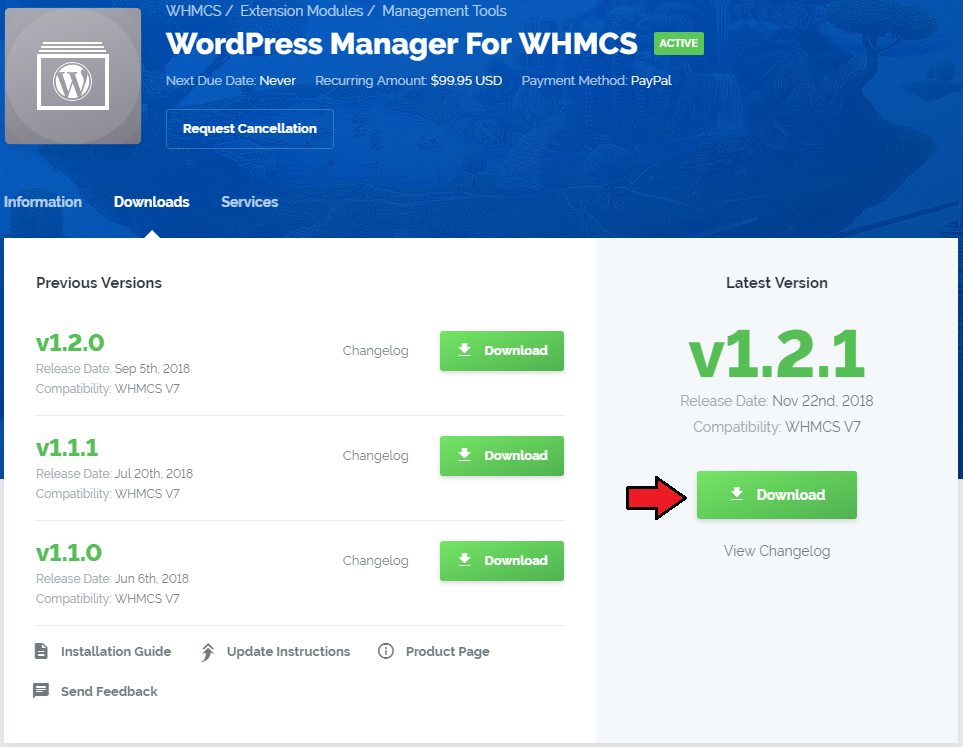
|
| 2. In the downloaded file you will find two packages that support different PHP versions. As presented on the screen below, the first one is dedicated to PHP 5.6 up to PHP 7.0, while the second one is aimed at PHP 7.1 up to PHP 7.2. It does not apply to open source versions. Note: You can check the current PHP version in your WHMCS. To do so, proceed to 'Utilities' › 'System' › 'PHP Info'. |

|
| 3. Choose the one with the right PHP version. In the package you will find another two folders. As presented on the screen below, the first one is supposed to be installed on WHM (cPanel), while the second one is aimed at WHMCS. |

|
cPanel (WHM) Installation
| 1. Upload and extract the 'UploadToWHM' folder into the /root cPanel directory. Files in your cPanel /root/uploadToWHM/ directory should look like these on the following screen. |

|
2. Once the module is uploaded, enter the /root/uploadToWHM/ catalog and run the following command in the console:sh install.sh After a brief moment you should see a confirmation that the plugin has been successfully installed. |
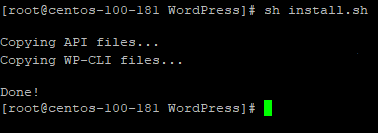
|
WHMCS Installation
| 1. Extract the 'modules' catalog into the main WHMCS directory. |

|
| 2. When you install WordPress Manager For WHMCS for the first time, you have to rename the 'license_RENAME.php' file. This file is located in 'modules/addons/wordpress_manager/license_RENAME.php.' Rename it from 'license_RENAME.php' to 'license.php'. |
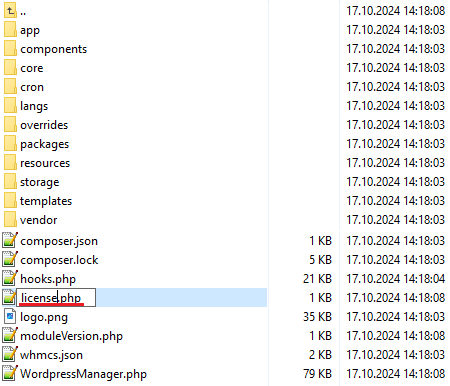
|
| 3. In order to configure your license key, you have to edit the previously renamed 'license.php' file. Enter your license key between quotation marks as presented on the following screen. You can find your license key in our client area → 'My Products'. |

|
| 4. In the next step, set up the 'storage' folder as recursively writable. This folder is available at 'your_whmcs/modules/addons/WordpressManager/' . |
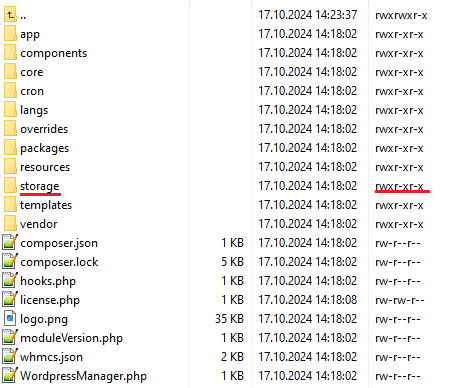
|
| 5. Now you have to activate the module in your WHMCS system. Log in to your WHMCS admin area. Click 'Setup' , then choose 'Addon Modules'. |
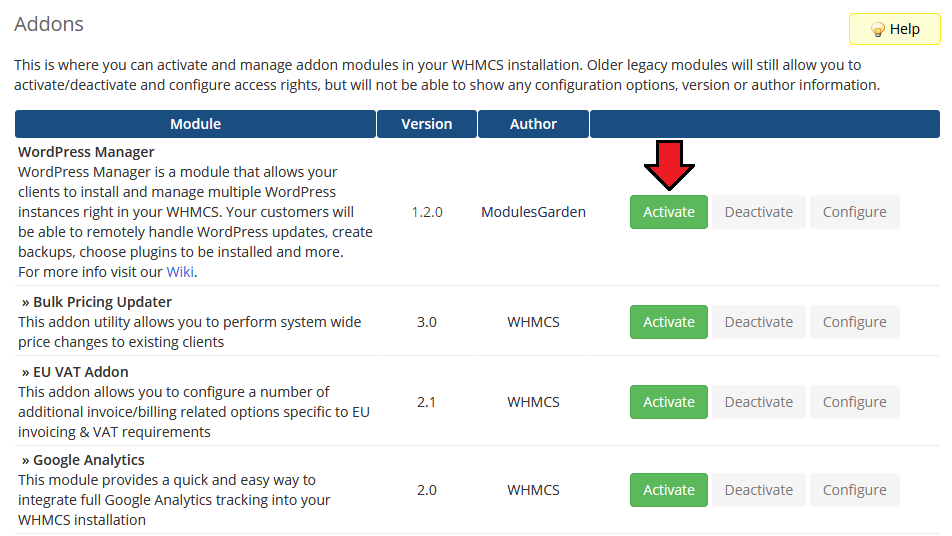
|
| 6. Then, you need to permit access to this module. To do so, click on the 'Configure' button, choose 'Full Administrator' and press 'Save Changes'. |
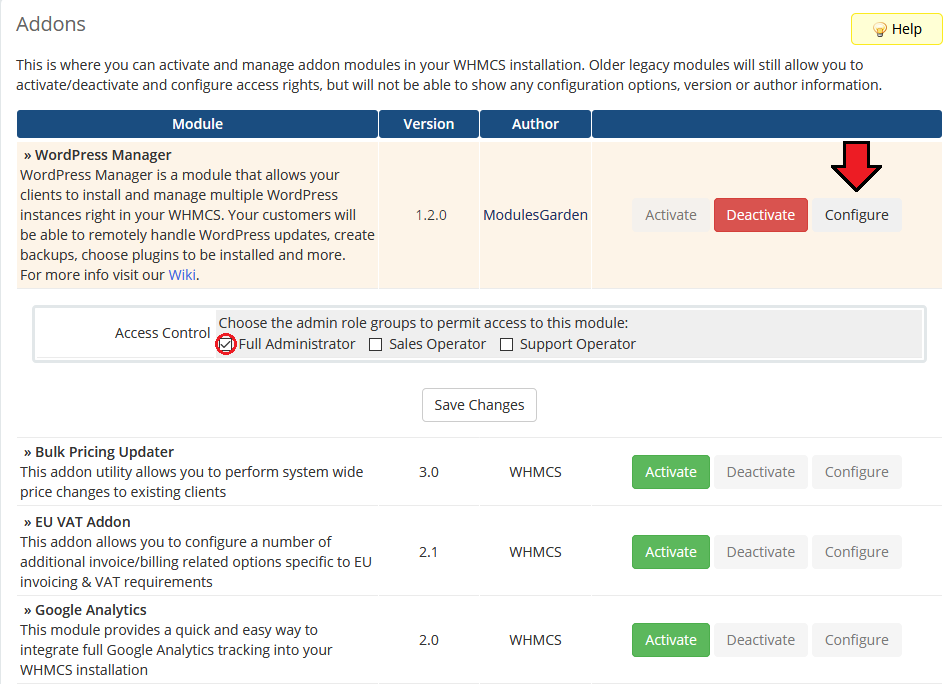
|
7. Now you have to add a cron job as shown below (5 - 10 minutes interval is recommended).php -q /your_whmcs/modules/addons/WordPressManager/cron/cron.php Synchronize Do not forget to replace 'your_whmcs' with your WHMCS root location. |
| 8. Good job! You have just successfully installed WordPress Manager For WHMCS! Now in your WHMCS press 'Addons' and then 'WordPress Manager'. |
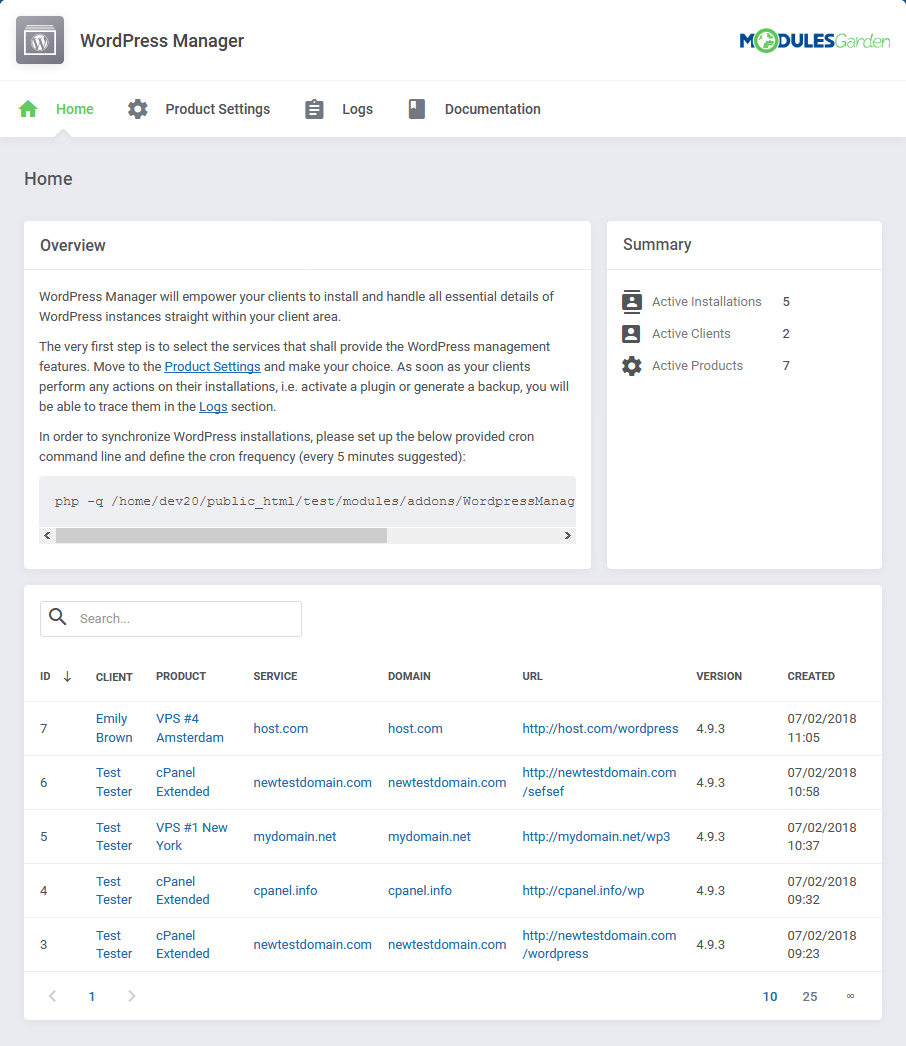
|
Management
| This section has been divided into two main parts to allow full and, at the same time, easy understanding of the functionality of the whole module. In the first part 'Management of Addon' you will see a general outlook of the module's basic configuration, through the product management from the admin area. The second part describes additional settings and tools concerning WordPress installations that can be used while working in the client area. |
Admin Area
| Now that your module is already configured, you may access it from 'Addons' → 'WordPress Manager' . |
Home
| 'Home' should be your first choice. In this section you will see all active WordPress installations and the list of the clients who already have them. |
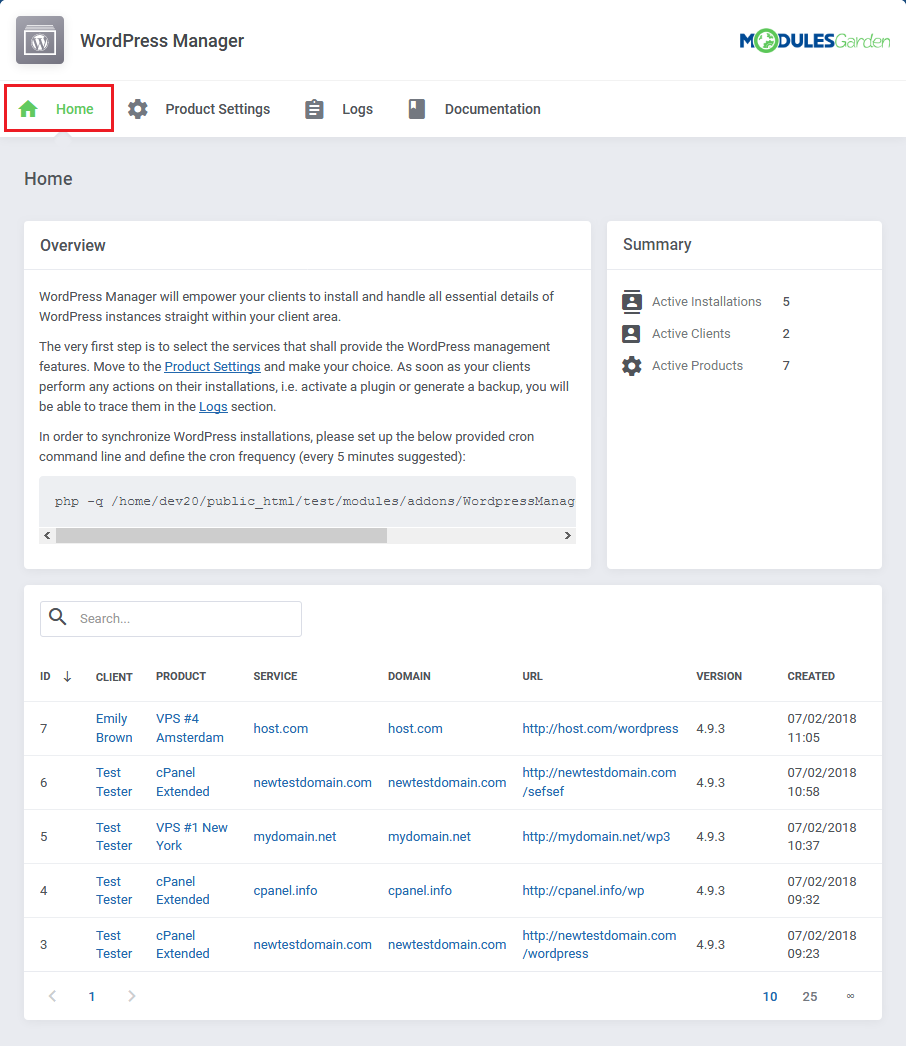
|
Product Settings
| In the 'Product Settings' section you can see the list of compatible products that WordPress can be configured with. |
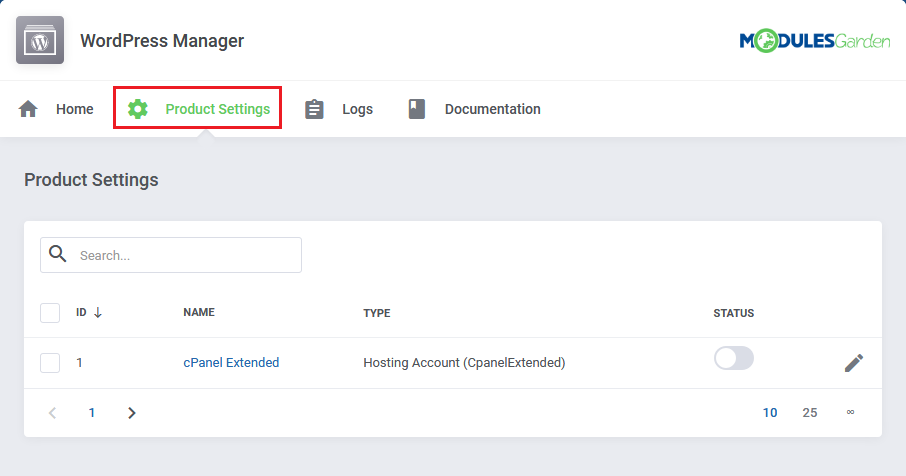
|
| Activate your product and press the 'Edit' button marked with the green arrow. |
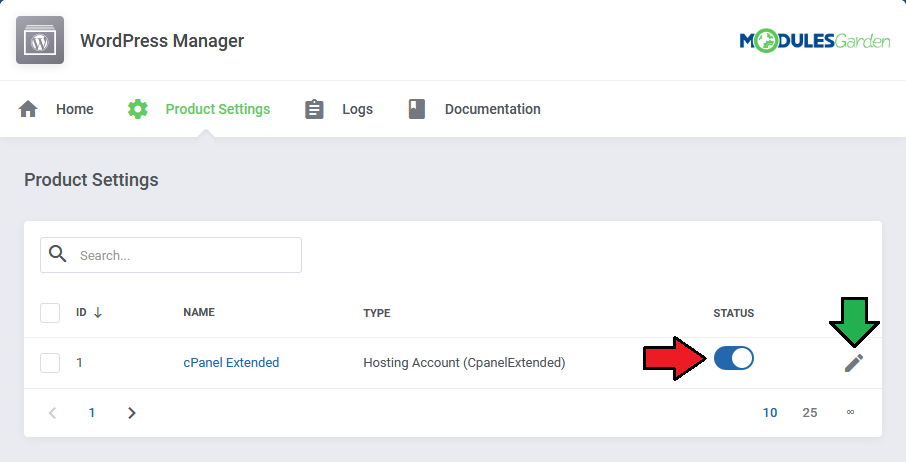
|
| Enabling Debug Mode will result in the module's activity details being gathered in the 'Logs' tab. |
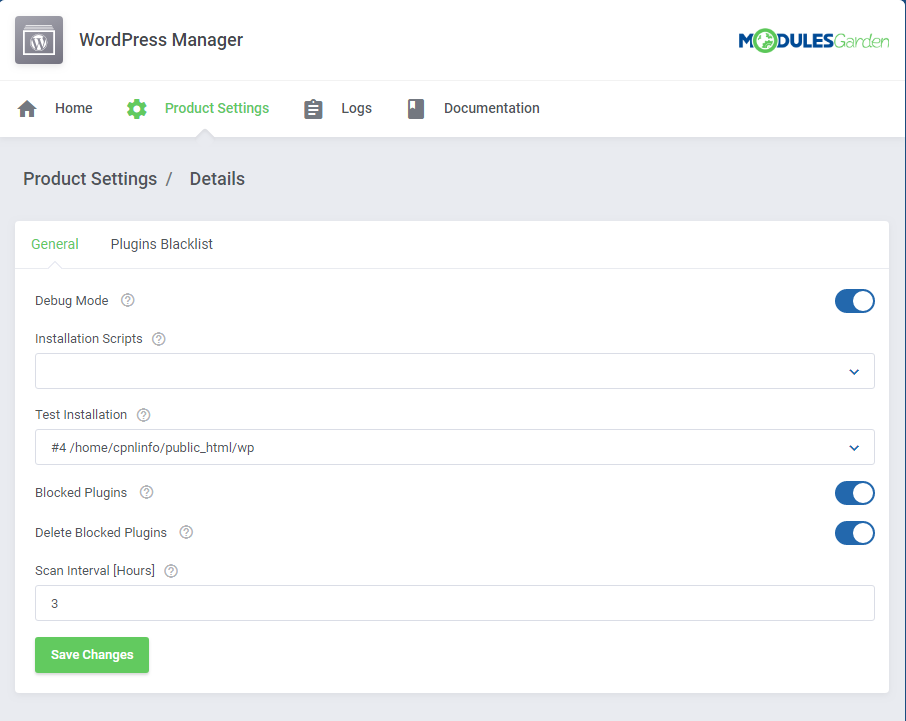
|
Logs
| All module activities are recorded in the section named 'Logs' . |
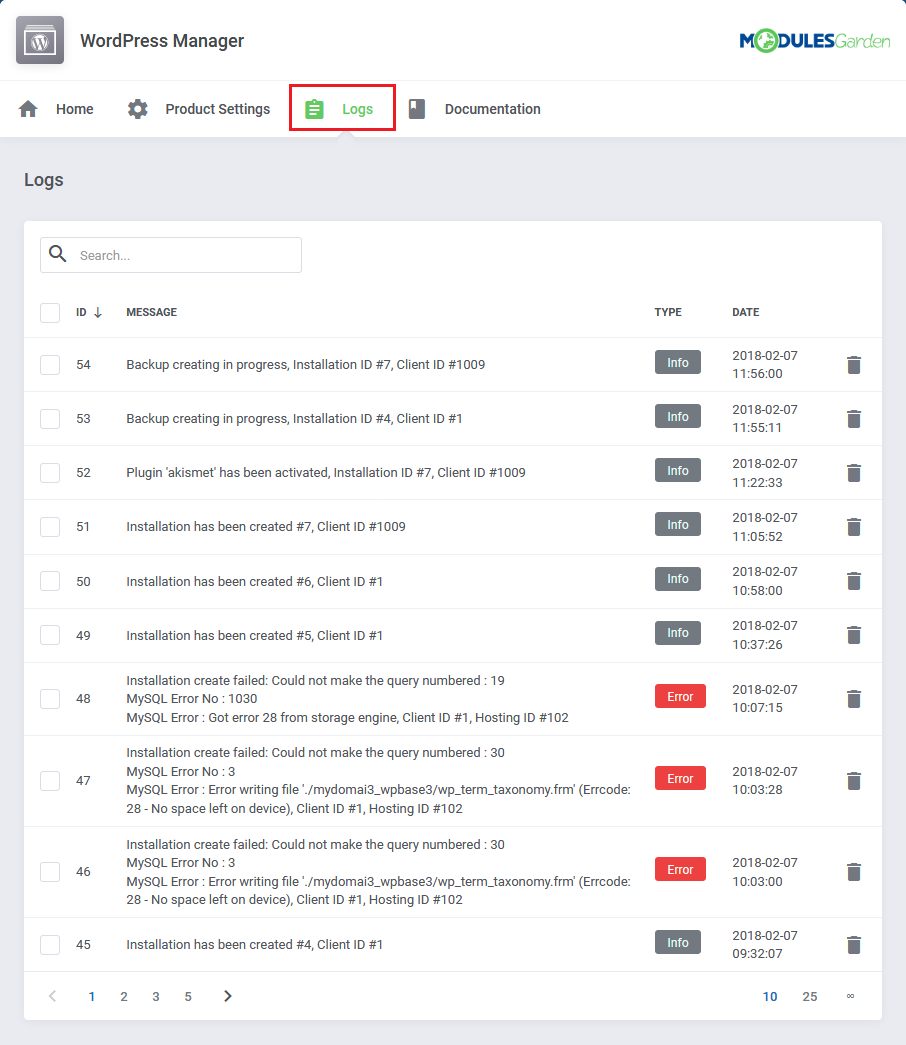
|
| All entries can be deleted separately. To do that, just click the button marked on the screen below. |
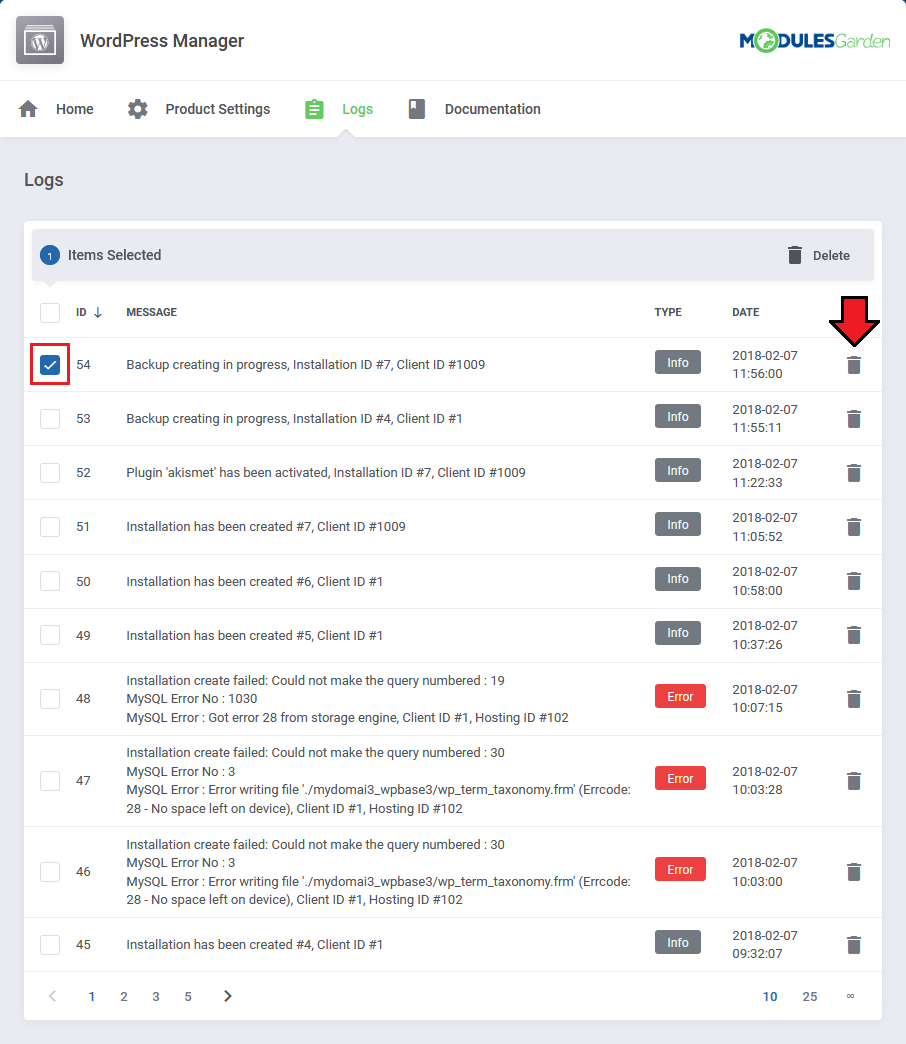
|
| Keep in mind that you can remove multiple logs at once. |
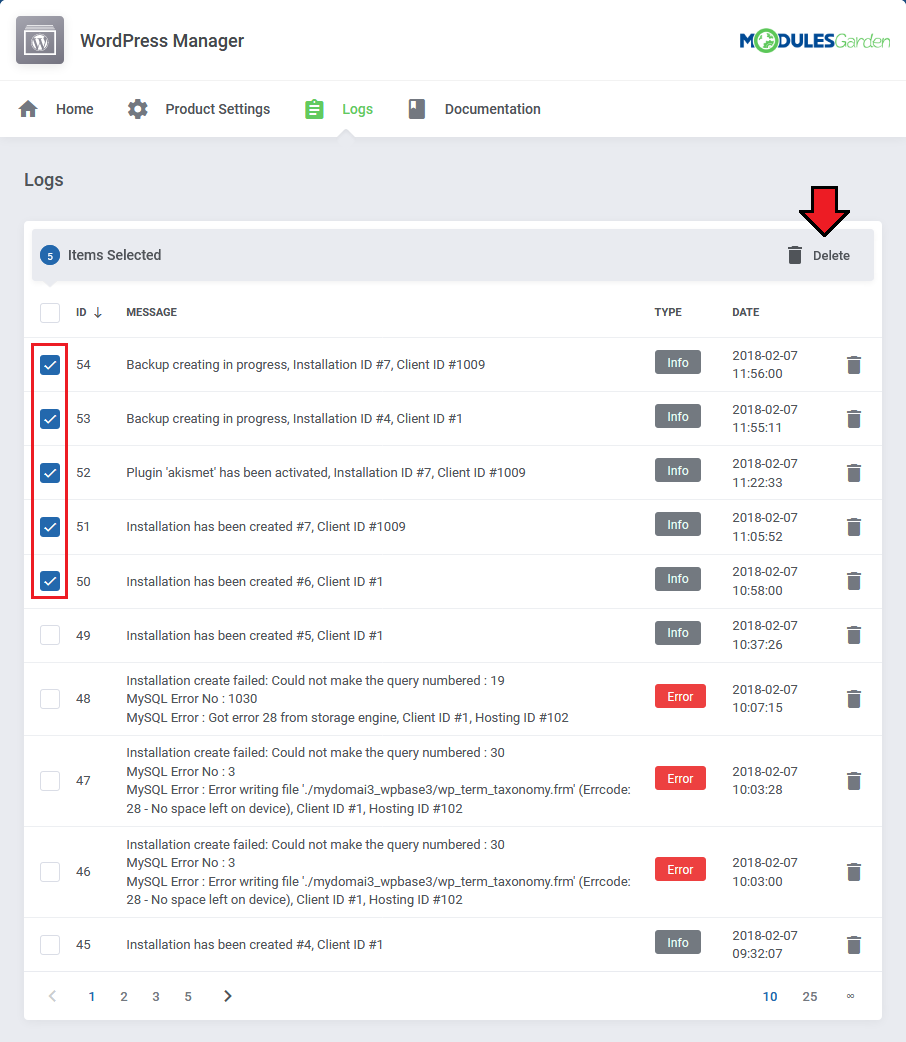
|
Client Area
WordPress Management
| Now that you already have the module configured, you may see the process of adding and and managing the WordPress installations by your clients. While in the client area, find the button 'My Services' and go to the section presented on the following screen. |
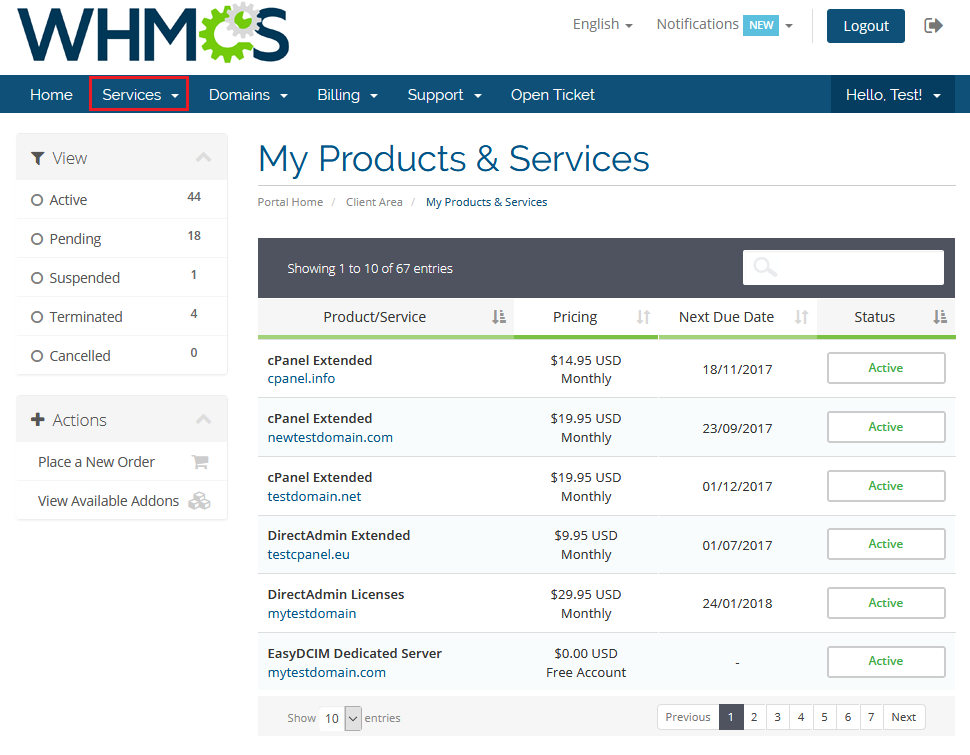
|
| Choose your product and enter its details. |
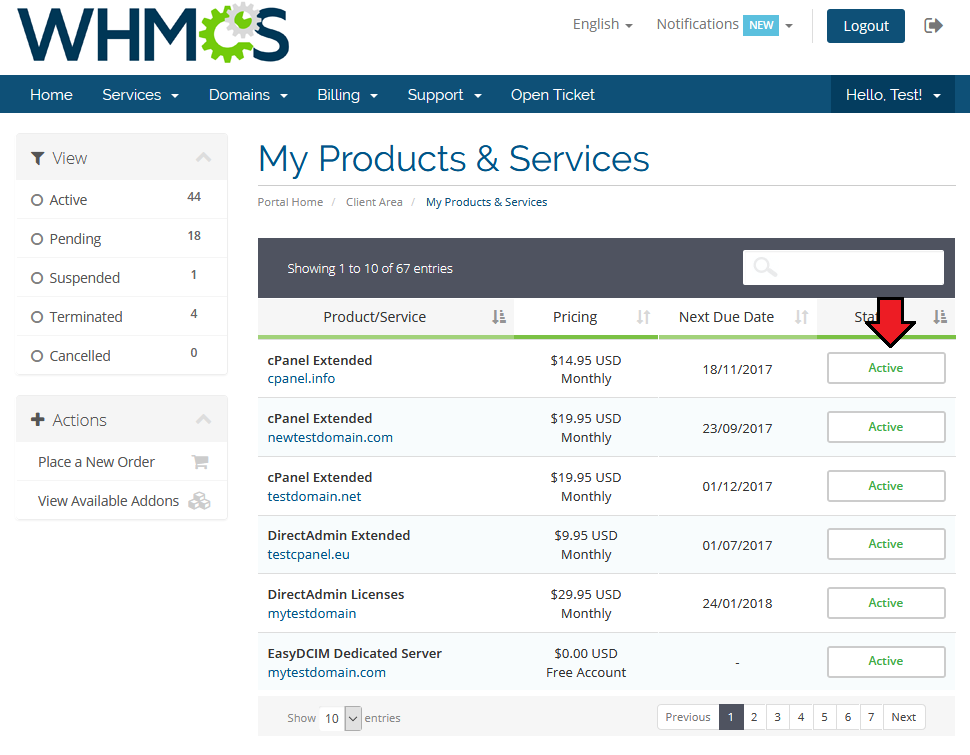
|
| Now, move directly to the 'WordPress Management' section. |
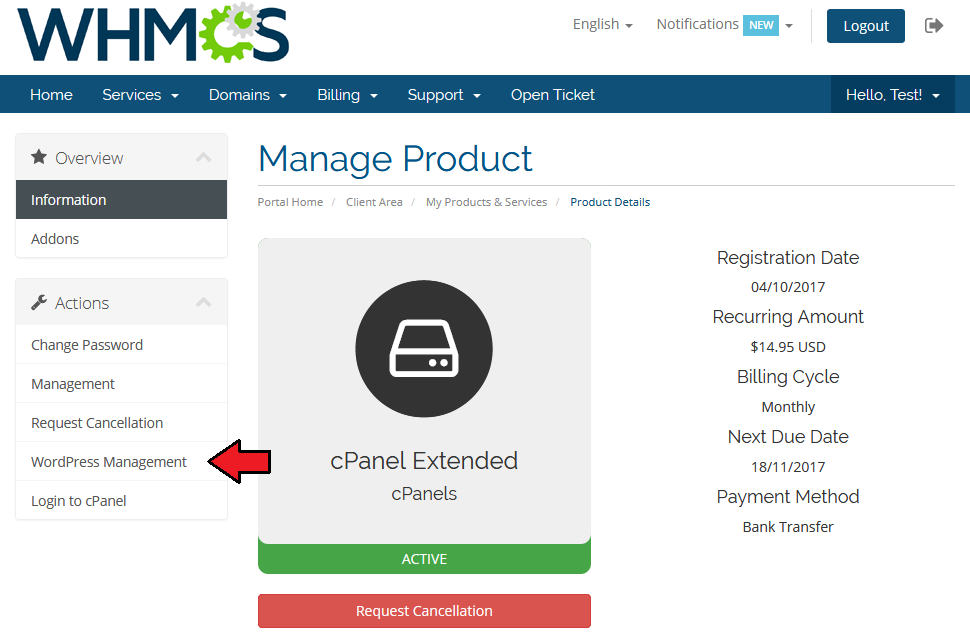
|
New Installation
| Next, you will need to add a new installation. Press the button marked on the screen below. |
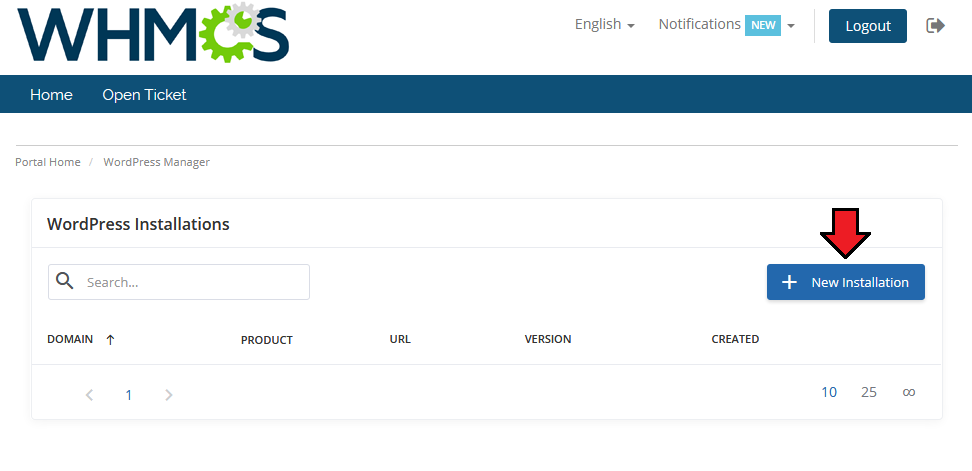
|
Fill in the fields. Note that only those marked with * (e.g. Database Name) are required to complete the creation:
|
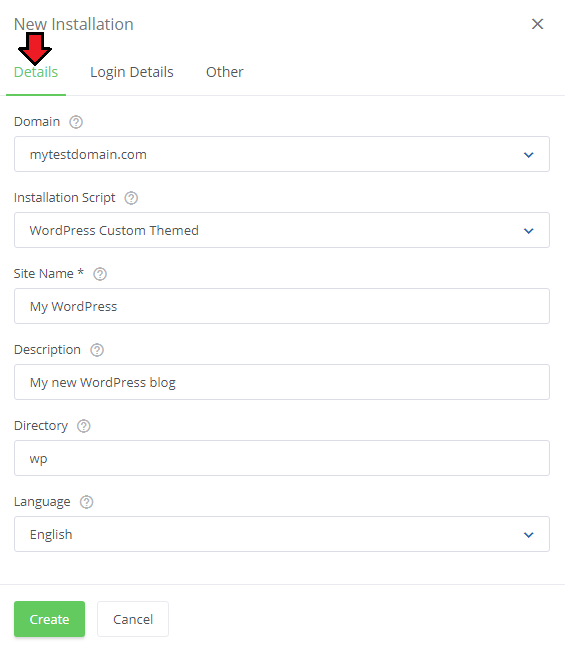
|
Installation Details
| Once you have successfully created a new installation, you can edit its advanced options (the green arrow) or simply remove it in case you no longer need it (the red arrow). Let us press the green one. |
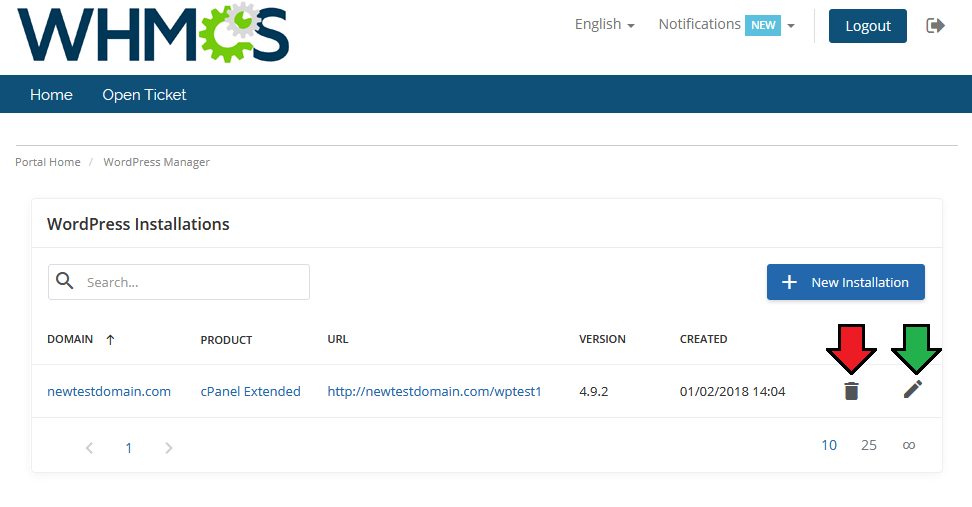
|
| This is how an example configuration of your installation may look like: |
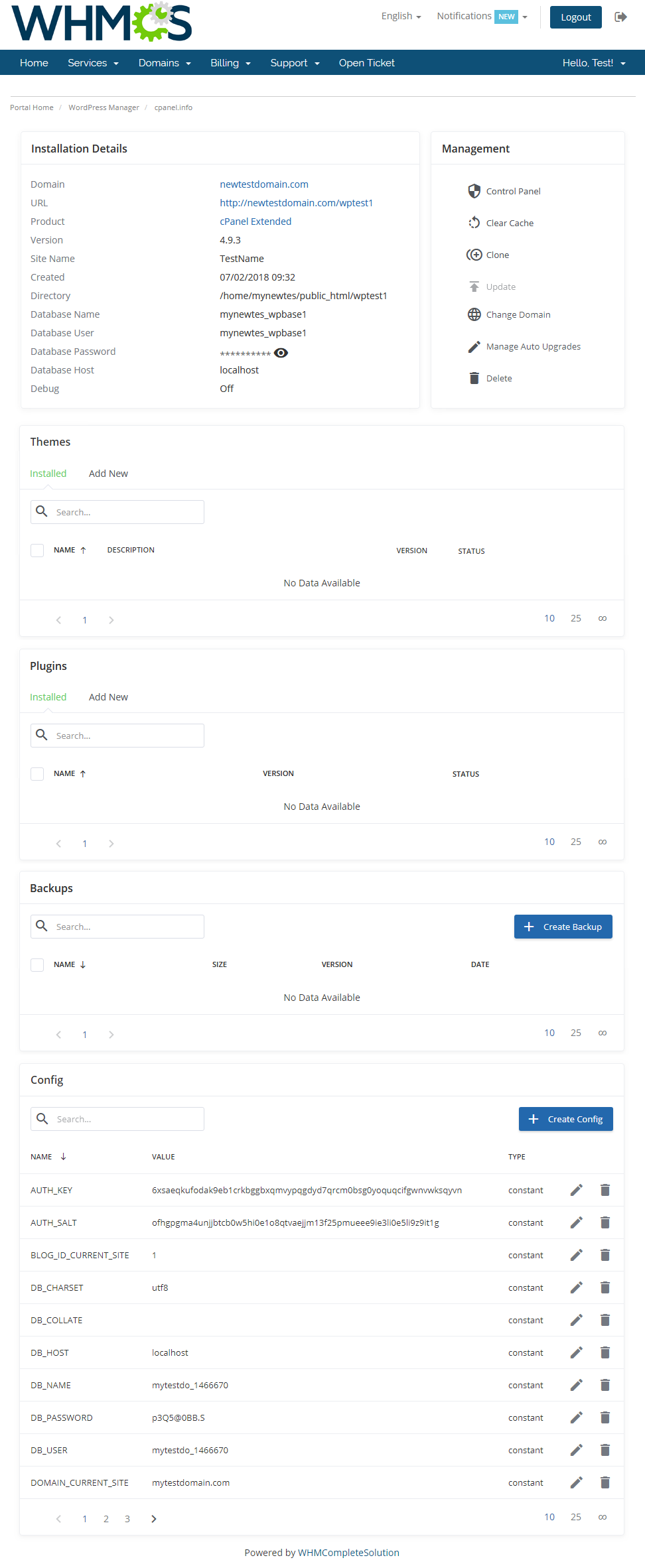
|
In the 'Management' area you can find the following options:
|
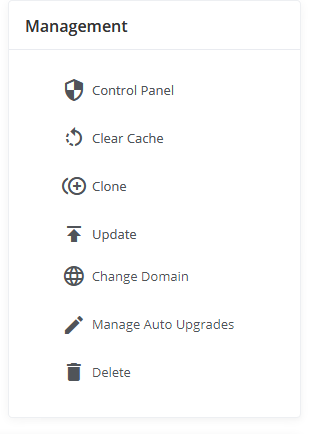
|
Plugins
| Here you are enabled to activate, deactivate or update the already existing plugins. You can also add new plugins to your WordPress installation in the 'Add New' tab. |
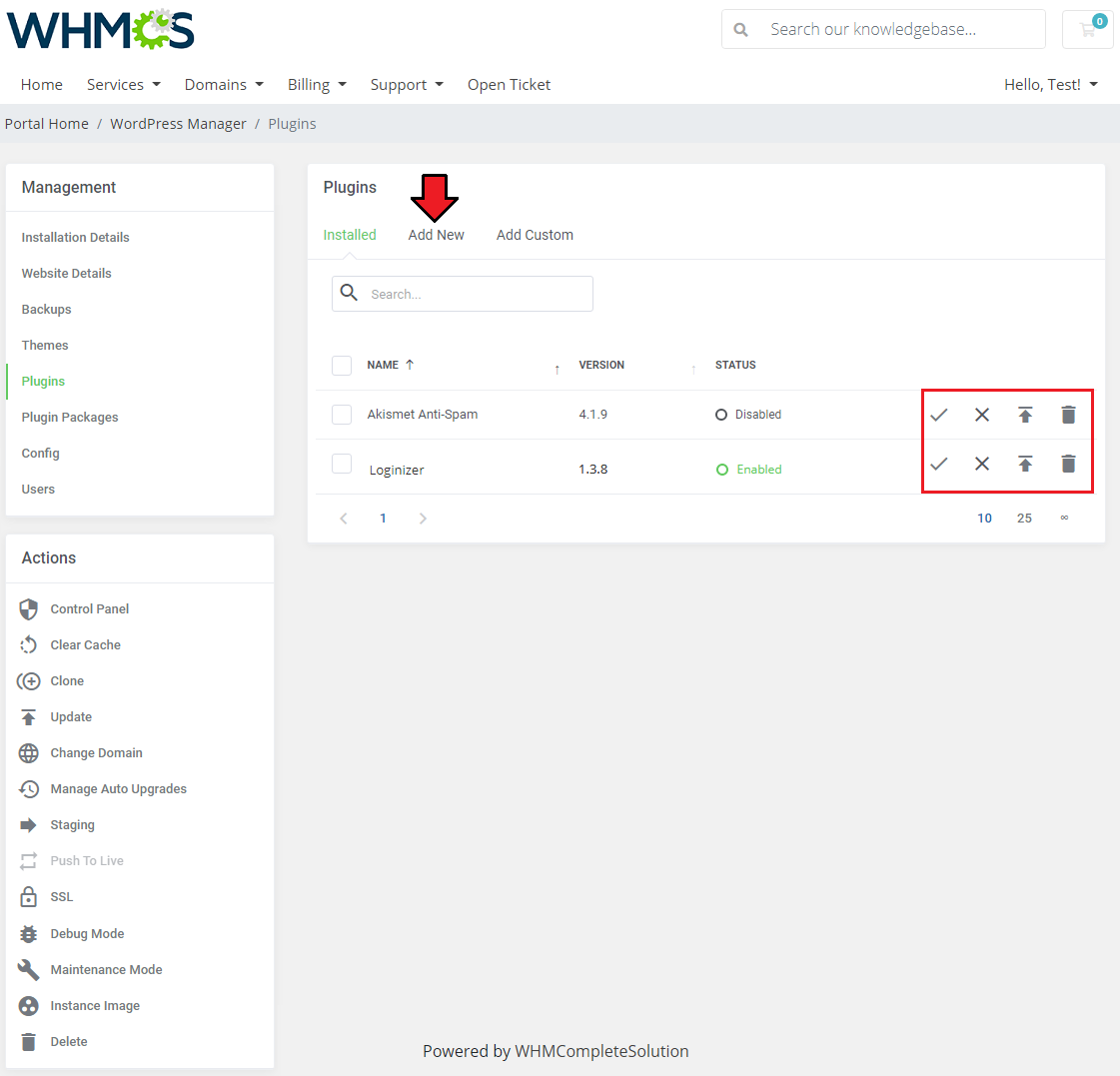
|
| To add a new plugin, you are required to type in at least the initial letters of the desired plugin's name into the search field to see the actual results. Afterwards, press the symbol marked on the screenshot below, and confirm your choice in the window that should be visible on your screen. |
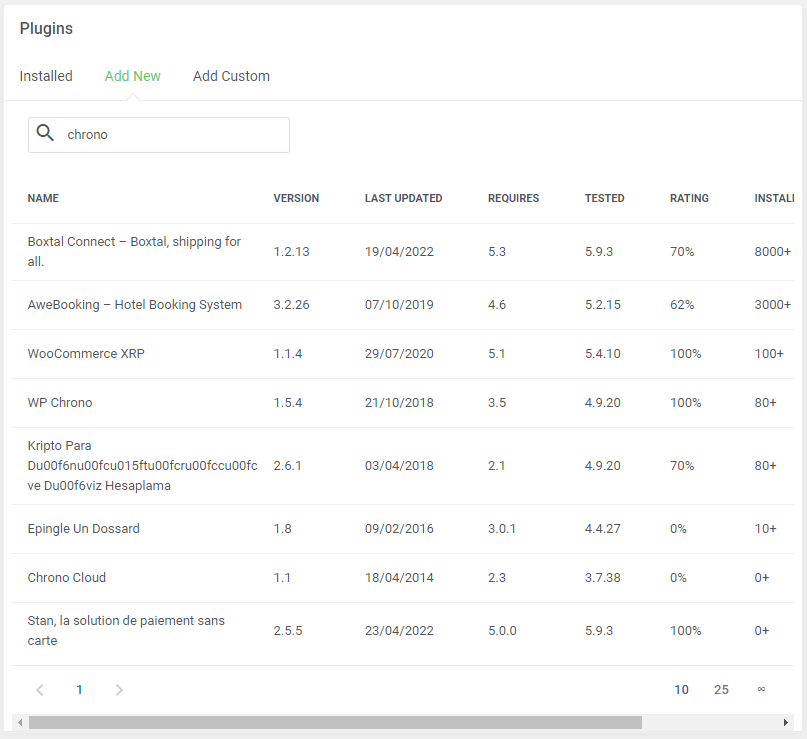
|
| The 'Mass Action' feature is also present in this section, so you will be able to handle multiple plugins more efficiently and at the same time. |
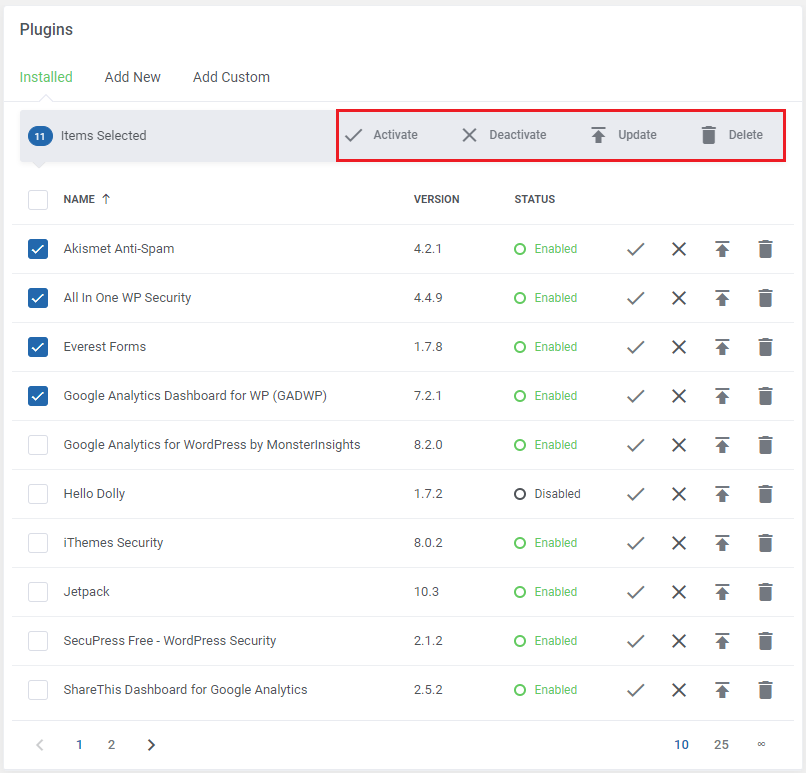
|
Backups
| As the name suggests, this section provides you with an ability to add or modify backups. You are allowed to download, restore and delete a particular backup. |
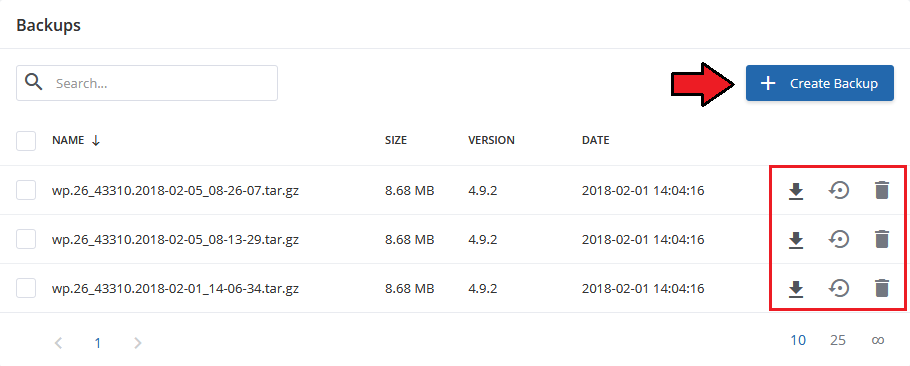
|
| Here you can delete multiple backups at once. See the screenshot below. |
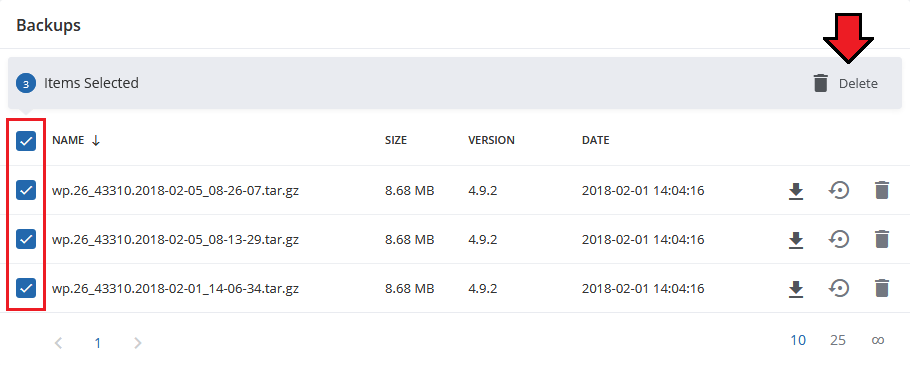
|
Tips
1. In case you wish to remove one of your plugins from WHM, make sure you delete the additional content too:
/usr/local/cpanel/Cpanel/API/Wordpress.pm /usr/local/cpanel/share/WordPressManager/wp |
Update Instructions
| Essential guidance through the process of updating the module is offered here. Keep in mind there is a quick and easy option in our client area that will let you upgrade the license of your module to an open source version at any time - and at a lower price! |
Common Problems
| 1. When you have problems with connection, check whether your SELinux or firewall does not block ports. |